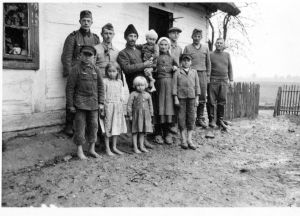Hrubieszow

Hrubieszow Poles and Germans
During the interwar period, there were some 7,000 Jews in Hrubieszow, about half the population. Most were merchants or petty artisans such as tailors and shoemakers. Jews owned flour mills, a printing house and various factories. The community had a savings and loan association, trade unions; chapters of various Zionist groups, Agudath Israel and the Bund, along with their respective youth movements. Hrubieszow was a distinctly Hasidic town where Hasidic courts were concentrated. Although most Jewish children attended government schools, some attended Hadarim, Talmudel Torah, a Hebrew speaking Zionist school, and a Yiddish –speaking Bund school. The Jewish community had two libraries, drama and literature clubs, and a sports team. Zionist journals in Yiddish were published in the town. In September 1939, Hrubieszow was occupied by the Germans, re-taken by the Poles, and later occupied by the Soviets. The Soviet forces left on 3 October under the terms of the Molotov- Ribbentrop Pact, after which the Germans returned. Many Jews, particularly young ones, joined the Soviets as they returned East. When the Germans returned to Hrubieszow they began abducting Jews for forced labour and looting their property. Sometime later, the Gestapo imposed a ransom on the community, and murdered the Rabbi. Yohanan Twerski.
On 2 December 1939, SS forces and a Ukrainian company rounded up 1,000 Jewish men aged 15 -60 and marched them to the River Bug, where the Soviet – Polish frontier had been drawn, along with 1,100 Jews who had been brought to Hrubieszow, from Chelm. Some 1500 were murdered during the four –day march. Many drowned, a few crossed the river successfully, and the others were brought back to Hrubieszow. One of those caught up in this Aktion was Hirsch Pachter and he recalled how craftsmen, shoemakers and carpenters were ordered to lead the march:
‘We started marching. One girl succeeded in following the marchers, shouting, “Father” all the way. At the first village, they took this girl away. We do not know what happened to her, but we heard a shot.’
Early on 3 December the march resumed. At the first village, three bearded Jews were led away: Shmuel Topocostok, Benjamin Rosenberg, and Loewenberg. As Loewenberg was led away, Pachter later recalled, ‘his son jumped up, and said, “Leave my father alone, I will take his place. Take me,” and they said ,”You come along too,” and they took both of them and the other two. Pachter added: ‘They were all shot in the back of their heads, and the bullets came out of their foreheads.” In early 1940, a ghetto was established in Hrubieszow for about 6,000 Jews from the town, and from other localities in the area. All Jews aged 12 and over were ordered to wear a white Star- of- David armband. The Germans appointed a twelve- member Judenrat headed by Shmuel Brand and his deputy, Joel Rabinovich. The Judenrat was often ordered to provide the Germans with forced labourers and to pay ransoms. The Judenrat set up a soup kitchen and hospital. In August 1940, about 500 Jews from Czestochowa arrived at the Hrubieszow ghetto. The Germans built four labour camps in the area and marched hundreds of residents of the ghetto to these facilities every day. On 13 August 1940, the Germans, assisted by Polish police, sent some 600 Jews to the Belzec Labour camp. About half of them died from starvation and epidemics. In November 1941, 300 Jews who had been deported from Krakow were brought to Hrubieszow; in March 1942 hundreds more arrived from Mielec. By May 1942, there were 5,690 Jews in the Hrubieszow ghetto. In the summer of 1942, the Germans informed the Judenrat of their intention to send the Jews of the town to the Pinsk area for labour. On 1-2 June 1942, the Germans, under the command of Gestapo commander Wiedermann, Gendarmerie Commander Hennig, and police officer Diamant, rounded up 3,049 Jews with the assistance of Polish policemen, and deported them to the Sobibor death camp.40 Jews who resisted were shot on the spot. On 7-9 June 1942, the Germans deported 500 additional Jews from Hubrieszow, Grabowiec Uchanie, Dubienka and Bialopole to Sobibor death camp. Many of the would-be deportees put up resistance and about 180 of them were murdered at the Jewish cemetery. Approximately 2,500 Jews remained in the Hrubieszow ghetto. They worked in the German factories and were concentrated in a small ghetto that was established near the cemetery. Beginning in 1941, the Dror movement ran a 40 member pioneer training commune, in the nearby village of Werbkowice. In August 1942, after the June deportations, its members intended to organise for partisan action but were murdered by the Gestapo.
On 28 October 1942, most inhabitants of the small ghetto- about 2,000 people- were deported to Sobibor death camp. Some 400 Jews who resisted during the deportation were executed in the cemetery. About 160 young people were left behind in Hrubieszow to clean up the ghetto area, and demolish the cemetery. In September 1943, the labour camp was liquidated, and its inmates, except for a few who managed to escape to the forest, were transferred to the Budzyn camp, near Krasnik.
Sources:
The Yad Vashem Encylopiedia of the Ghettos During the Holocaust Volume 1 , Yad Vashem, 2009.
The Holocaust – The Jewish Tragedy, by Martin Gilbert, Collins London 1986
Photograph - Chris Webb Archive
© Holocaust Historical Society 2014

